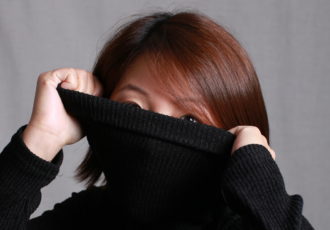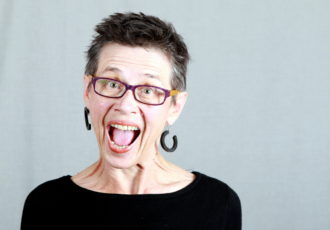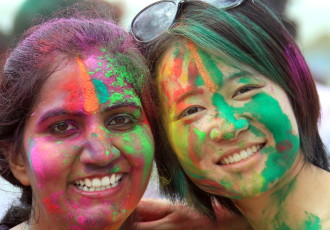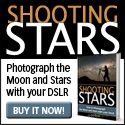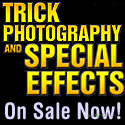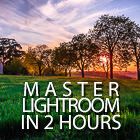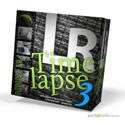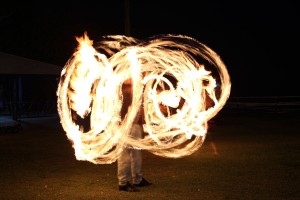 If you’ve not tried it before, photographing Fire Twirlers, Fire Breathers and other types of fire performers can be a little tricky. For maximum effect, most performances of this type are done in low light (if not completely dark) areas so apart form anything else, you need to be fairly comfortable with your camera’s layout and how to change settings without too much fiddling about.
If you’ve not tried it before, photographing Fire Twirlers, Fire Breathers and other types of fire performers can be a little tricky. For maximum effect, most performances of this type are done in low light (if not completely dark) areas so apart form anything else, you need to be fairly comfortable with your camera’s layout and how to change settings without too much fiddling about.
Like most things photographic, there is no “definitive setting” that must be used to take these types of photos – as the specific situation, and the type of effect you are trying to achieve will vary… but this post provides a guide to some of the basic settings you should start out with – and gives some ideas about things you could try to change the effect.
Low Light Photography Fundamentals
As this is a low light situation, it is most likely that you will use longer shutter speeds so stability is critical (hand holding is not really ideal for anything less than than 1/50th of a second). The following basics are suggested for low light photography :
- A sturdy tripod is highly recommended (alth0uhg you could probably manage with a stable surface, such as a table or backpack at a pinch).
- A remote trigger or cable release, although a shutter delay can be used if you don’t have a remote trigger
- Manual Focus – in low light auto focus tends to be unreliable
- Turn OFF image Stablilisation – you should do this any time you use a tripod as it can actually introduce movement
- As low an ISO as possible – I suggest starting at ISO 100 and only increasing it if necessary to reduce shutter speeds
- A fairly large (narrow) Aperture – I suggest F8 or higher as this will give a decent depth of field (allowing you to focus over a wider area) and show more flame
detail – as opposed to flame trails (unless of course this is the effect you are after).
Experimenting with Settings
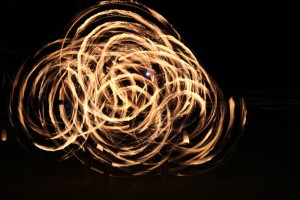 Once you have the basics (above) setup, take some trial shots and adjust some of the settings outlined below to create the effect you are trying to achieve
Once you have the basics (above) setup, take some trial shots and adjust some of the settings outlined below to create the effect you are trying to achieve
- Location – check the background and try to minimise other light sources… Street lights, Cars and other lights can be a distraction and ruin the shot. Try to locate yourself somewhere where the background is as dark as possible.
- Shutter Speed – Long shutter speeds (5 secs +) can produce interesting effects , but can be very cluttered and busy. You will probably find that shorter shutter speeds (1-3 secs) may be best, although this will depend on the effect you are after and the type of fire performance.
- Aperture – decreasing (widening) the aperture will decrease the depth of field, making it harder to have the whole performance in focus (particularly if the twirler is moving around), but increasing (narrowing) the aperture will require longer shutter speeds or higher ISOs.
- White Balance – Daylight balance is probably best to start off with as it will give you a warm looking result, but you can try experimenting with this for different effects – Cloudy and Shade settings will warm it up, whereas Tungsten and Flourescent will create a bluer (colder) effect.
- ISO – Don’t increase your ISO too much. Most long exposures (especially at night) will produce a lot of noise using higher ISOs. If you want to decrease the shutter speed or freeze the motion, increasing ISO is an option though.
What about Flash ?
If the focus of your photo is to be the flame itself then you wouldn’t consider using flash. However, if you want the performer to be a feature, you may like to consider flash to highlight and freeze the motion.
Without using flash, the performer will be blurred and/or ghosted. To bring the performer into focus you may like to try using a a slow shutter speed to capture the environment and a flash strobe to freeze the performer. This will give you the benefit of capturing your fire trails with a sense of movement and fluidity, while also having your fire spinner in sharp focus.
For fire trails, a flash technique worth trying is rear (or 2nd) curtain sync – this means that the flash fires at the end of the exposure and when doing long exposures is a good way to get fire trails and still freeze the performer. (Check your camera to see how to setup 2nd Curtain sync).
Note that direct on-camera flash can be cold and flattening – a side strobe light or off-camera flash could be ideal to add drama and depth to your image.
It can be a delicate balance to find the right settings to create good fire trail photos – each situation will be different depending on available light and how fast the performers are moving. However, following the steps in this guide (and experimenting) should provide you with a good basis for creating interesting and impressive photos of fire.
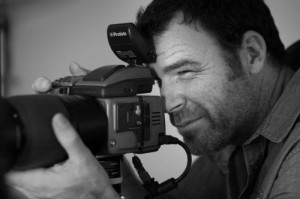
 A model release is a legal document that gives a photographer permission to use a model’s likeness to create and sell content covered by the release. It will often also state that the model will not be further compensated beyond what is agreed on at the time of the shoot.
A model release is a legal document that gives a photographer permission to use a model’s likeness to create and sell content covered by the release. It will often also state that the model will not be further compensated beyond what is agreed on at the time of the shoot. Many photographers will work with models, stylists or makeup artists on a trade basis – providing professional photos for your portfolio instead of paying you in dollars This time for print (tfp) or time for cd (tfcd) is an effective way to gain images to add to your emerging portfolio.
Many photographers will work with models, stylists or makeup artists on a trade basis – providing professional photos for your portfolio instead of paying you in dollars This time for print (tfp) or time for cd (tfcd) is an effective way to gain images to add to your emerging portfolio.

